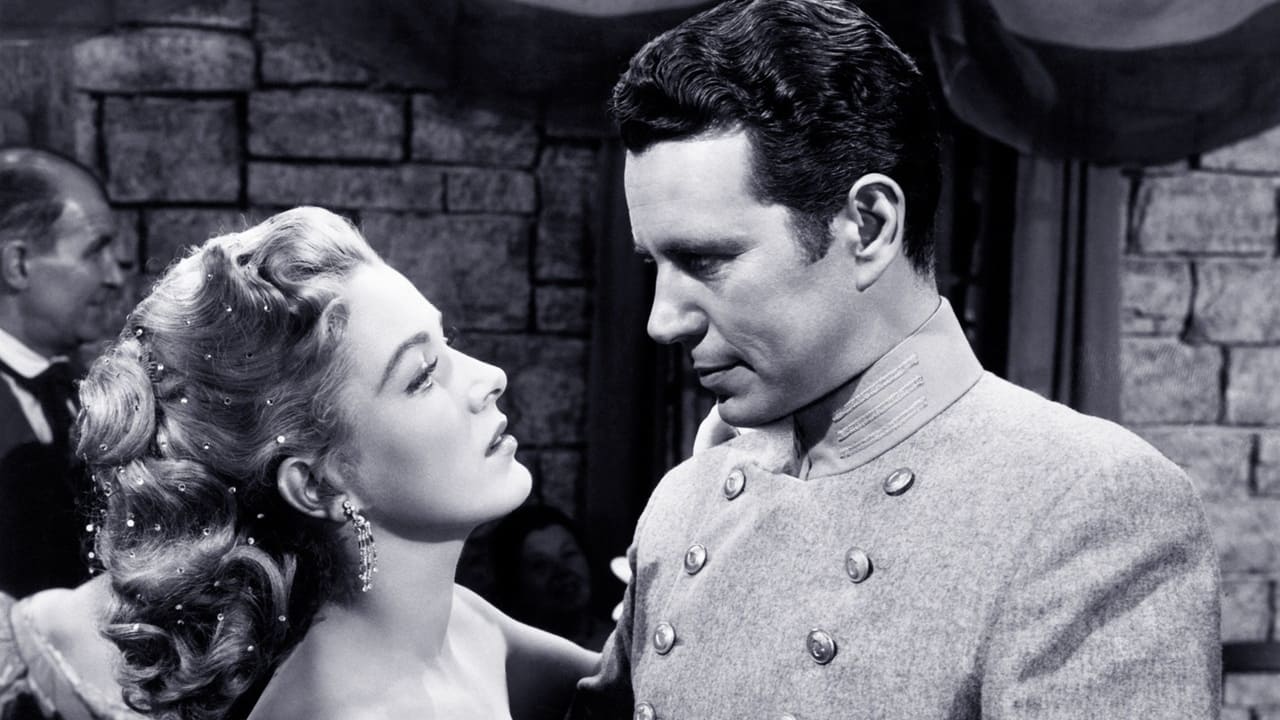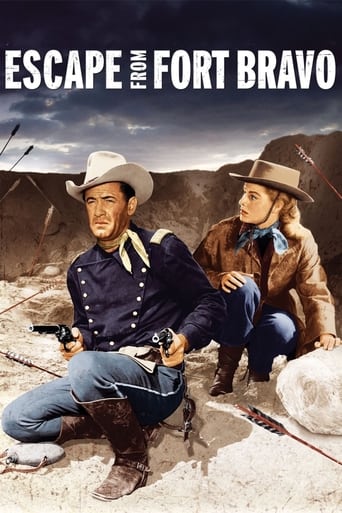

good back-story, and good acting
... View MoreIt's the kind of movie you'll want to see a second time with someone who hasn't seen it yet, to remember what it was like to watch it for the first time.
... View MoreA film of deceptively outspoken contemporary relevance, this is cinema at its most alert, alarming and alive.
... View MoreActress is magnificent and exudes a hypnotic screen presence in this affecting drama.
... View MoreMGM did not make many westerns but we knew when an MGM would come along it would be good and this one surpassed our expectations. How successful it was among the guys in my class in high school in the fifties! Most westerns had tepid love stories, but this had a torrid one with William Holden as the tough Capt. Roper and Eleanor Parker as the troublesome Carla Forester. No need to praise the director John Sturges he has to his credit "The Magnificent Seven", "Bad Day at Black Rock" and "Gunfight at the OK Corral". And what a supporting cast with Polly Bergen, William Campbell (Man Without a Star), John Forsythe Frank Fenton who wrote the screenplay also did "Garden of Evil", "Ride Vaquero" and "River of no Return". And Robert Surtees the cinematographer has a lot of great films to his name. In spite of all those names, we know sometimes it can go wrong but not here. When they are surrounded by the Mescaleros, it is tense and exciting, memorable scenes. Don't miss this one.
... View MoreFor Every Good Thing in this Glossy Western there is something that keeps it from being a Fine Film. Although it is above Average. The Outdoor Sun Drenched Sprawl is Striking and the Sense of Open Space among Sharp Protruding Mountain Rocks is Excellent. Then there is an Outdoor Scene that is a Fake and Obvious Studio Set and it Releases the Viewer from any Suspension of Disbelief.It is an Attractive Color Movie that Draws Unneeded Attention to itself with Stiff Starched Ultra Clean Costumes and Salon Hair-Do's. Even the Confederate Prisoners are Groomed and Look Spiffy. There is some Sharp Dialog, mostly from Crusty William Demarest Sparring with a Youngster, but then there is the Clunky Banter between William Holden and the Immaculately Dressed Eleanor Parker that is at times Cringe-Worthy. "What makes you so sure of yourself?... The way you light a man's cigar."The Best Part of this Over Produced Western is the much Talked about Climax that has an Indian Attack with the Mescaleros using some Military Artillery Tactics and the Standoff is Staged just a bit Off Key and that Boosts the Movie to just Above Standard Stuff despite all the Effort from MGM to make this something Special. It was the Studio's Prissy Attitude and Obsession with Gloss and Sheen that has kept this in Unnoticed Unremarkable Territory.
... View MoreI had written a review of this film under a different variation of my name, but I watched it again, and learned a few things that I missed, so I am reposting and adding. What I missed was perceptive the character of Campbell (William Demerest who played Uncle Charlie from "My Three Sons") was. His remarks to fellow Confederate Soldier Cabot Young (William Campbell) were priceless. Like when Young asked him about old men fighting the war, and he said "Because you young men are losing it." Or when he said "Just go to sleep, I will wake you up when you are dead." Spoilers Ahead: He knew he would not survive, nor would Young (check out how they died together, at the hands of Indians). I do not think it was any accident about how linked the characters were (the name "Campbell" or the word and name "Young" were not there but accident). You could look at this as a father and son relationship or the Confederacy losing to the Union (or both). They were supposed to be comedic, but there were serious messages hidden in the comedy (messages I missed). As far as the main character, Capt. Roper is concerned, it certainly helped having William Holden in the lead. Holden excelled at Westerns ("The Wild Bunch", "Alvarez Kelly", "Streets of Laredo", "The Horse Soldiers" & "The Man From Colorado" to name a few), as he did in almost every film he was in. This film is no different. What makes it work is the complexity of the character Capt. Roper (an interesting name for a jailer (and again no. This is a man who is as tough as nails, and makes Javert (From Les Miserables), or Lt. Gerard (from "The Fugitive") seem like normal people, the way he hunts down Confederate Prisoners like animals (Like he did with Bailey (John Lupton)). Note: Even the name Roper is an interesting name for a jailer and how he captures escaped prisoners (and again not done by accident). Yet, underneath it all, there is a very different person. He does stuff like grow roses "Roper's Roses" that would be unexpected from such a hard a**. I love the relationship between him and Carla Forester (Eleanor Parker), who is very much like him (putting love and happiness last (but unlike Roper, does not know it)). She is a Confederate Spy who is engaged to Capt. Marsh (John Forsythe), and breaks him out of the stockade, and goes with him, not because she wants to, but because of duty and obligation. Marsh, who is the other major character in the film, is another very interesting character, he (like Campbell) seems to know that things will not work out the way he planned. Spoilers ahead. He knows that Carla really belongs to Roper, like when he had to snap at her to go with him when he and the other Confederate Soldiers escaped, and when after a fight and he was mortally wounded, he told Roper that Carla fell in love with him, and she only did her duty (Helping them escape). Finally he died with a smile on his face when Bailey (The only Confederate soldier to survive), ending up learning from Roper & Marsh how to be a hero, by escaping the Indians, and instead of running away, like he did earlier, he went back to the fort, and brought back the soldiers to save Roper, Carla, and Lt. Beecher (Richard Anderson), who was the only other survivor (interesting that Campbell somehow knew that would happen?). He also knew that Roper was the right person for Carla, because of his willingness to sacrifice himself for her and Beecher (When he went out to face the Indians alone, just before the Calvary showed up). Now in real life, it would be logical to assume that Carla would be Court Martialed and imprisoned for being a spy (they wound not hang a woman back in those days), and Bailey would be returned to the POW Camp to wait out the Civil War's end. But you get the feeling that since they were far from Washington, Col. Owens (a very wise, decent and humane Commander), would let Bailey go home (as a reward for saving Roper and especially Beecher (who married his Daughter, Alice)), and since no Union Soldiers died in the escape, he will probably let Carla go as well. Why? He never liked Roper's harsh tactics, and Roper might be even harsher to prisoners (or simply stops doing his job) if Carla is locked up, so why not simply let her go (provided Roper goes far away with her?). By freeing both Bailey and Carla (and taking Roper out of the equation), he can create a better POW Camp for everyone involved (certainly the Rebel POW's will appreciate that act, and Owens may need their help with the Indians down the line). Basically in the end, Roper goes from a "Roper" to being "Roped BY her" and like Bailey, is able to erase his personal demons, by physically and psychologically "Escaping From Fort Bravo." I really love this movie, and it deserves my highest praise 10/10
... View MoreI don't know if many females watch westerns, especially those that are not on the main radar of well-known westerns like those by John Ford. As a horse lover who grew up riding either western or bareback on my grandparents' farm, I've always had an affinity for western films. Sometimes I'm in the mood for a good western, so that is how I came to watch Escape from Fort Bravo (1953).I chose this film in particular because I like to see William Holden when he was just hitting his stardom, and before his alcohol abuse had aged him prematurely and affected his magnetism. I also enjoy Eleanor Parker. Although her career never reached the peak of Holden's, she is a fine actress that always improves a film. It also has a strong supporting cast of familiar actors who had enduring careers on American television.The story has been described in many of the reviews already. My only addition is that the romantic elements aid this film to that of "A" western status. The romance ensures that Holden's vulnerability is truly exposed. Who would have guessed that this type of man would not only have a green thumb but also fall so deeply in love? That he would have a yearning for something bigger, something more in his life than being a power hungry soldier. If he was just the cruel, by-the-book captain, there would be no reason to care whether he survives the onslaught of the Indians. It would just be another North against the South picture with an unfeeling Union captain who one might hope would get caught in the crossfire of the attack.The costuming, location setting, and glorious color all support the romantic elements as well. The female costuming was beautiful and women of any status would have dressed well even if it was impractical for the desert. Women still dress impractically in most cultures today. Also, other than one breakdown as doom sets in, Parker was given few lines during the climactic gunfight and never begged to be taken away or distract Holden from his command. I think Sturges used Parker's character well, but he didn't let her get in the way of the main draw which was the action and adventure.I probably would have given up on the film if Holden had stayed in a perpetual bad mood and continued to incite the prisoners and even his fellow soldiers with his barbaric methods for wrangling in escapees. The romantic elements made him a character to care about with the dilemma around Holden and Parker adding to the suspense. The romance gives the film a bit of an epic feel and not just that of a western. I get the feeling that this was intentional and not just a byproduct of a sidebar romantic plot device. All of these things, including the score and the melancholy song sung by the rebel soldier, take this film up a notch and ensure its "A" western status.
... View More